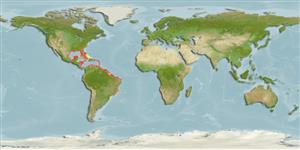Teleostei (teleosts) >
Tetraodontiformes (Puffers and filefishes) >
Diodontidae (Porcupinefishes (burrfishes))
Etymology: Chilomycterus: Greek, cheilos = lip + Greek, mykter, -eros = nose (Ref. 45335).
More on authors: Jordan & Rutter.
Environment: milieu / climate zone / depth range / distribution range
Ecology
Marine; reef-associated; depth range 1 - 44 m (Ref. 9710). Tropical
Western Atlantic: southeastern Florida, USA and the Bahamas to northeastern Brazil (Ref. 13608).
Size / Weight / Age
Maturity: Lm ? range ? - ? cm
Max length : 30.0 cm TL male/unsexed; (Ref. 26938)
Dorsal
spines
(total): 0;
Dorsal
soft rays
(total): 13;
Anal
spines: 0;
Anal
soft rays: 11 - 12. Body with five or more black blotches and a fine network of lines which cuts off pale, cell-like areas (Ref. 5521). Spines short, especially those ventrally on body, and rigidly erect; 12 spines in an approximately row from front of head to dorsal fin; a large black spot above pectoral fin and a smaller one beneath and posterior to fin (Ref. 13442).
Inhabits coral reefs with adjacent seagrass and rubble areas (Ref. 9710). Between 1995 and 2000, at least 10 specimens have been traded as aquarium fish at Ceará, Brazil (Ref. 49392).
Life cycle and mating behavior
Maturity | Reproduction | Spawning | Eggs | Fecundity | Larvae
Uyeno, T., K. Matsuura and E. Fujii (eds.), 1983. Fishes trawled off Suriname and French Guiana. Japan Marine Fishery Resource Research Center, Tokyo, Japan. 519 p. (Ref. 13608)
IUCN Red List Status (Ref. 130435)
Threat to humans
Harmless
Human uses
Fisheries: of no interest
More information
Common namesSynonymsMetabolismPredatorsEcotoxicologyReproductionMaturitySpawningSpawning aggregationFecundityEggsEgg development
ReferencesAquacultureAquaculture profileStrainsGeneticsElectrophoresesHeritabilityDiseasesProcessingNutrientsMass conversion
Tools
Warning: mysqli::__construct(): (HY000/1040): Too many connections in /var/www/html/includes/speciessummary.lib.php on line 2414
Can't connect to MySQL database fbquizv2. Errorcode: Too many connections
